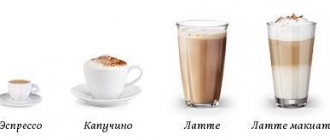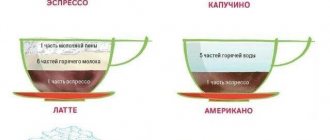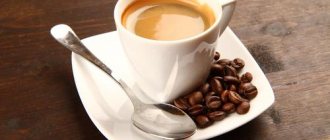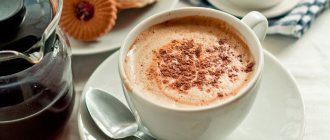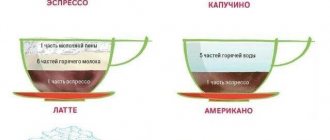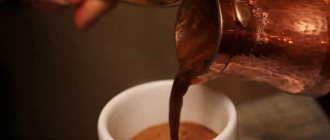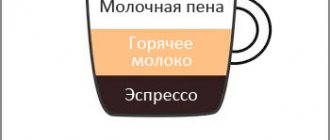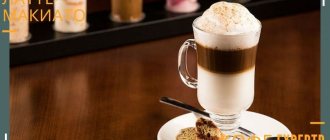Caffe latte is a drink based on whipped milk and coffee, with a predominance of milk. Latte has gained great popularity in Europe and America due to its mild taste and beautiful presentation. How to prepare and serve a latte correctly, how to find out the calorie content of a serving and which syllable to emphasize in the name of the drink? We'll tell you everything you need to know about lattes and a little more.
Caffe latte: what is it?
Is a latte coffee with milk or milk with coffee? In our opinion, the last statement is more true. And the name of the recipe itself confirms its attraction to the dairy component. “Latte” translated from Italian means “milk”.
- Who and when first made latte coffee is still unknown. Italians attribute the authorship to themselves, rightly emphasizing that the name is Italian. The French claim that they themselves are quite capable of preparing cafe au lait. The Austrians recall that they were the first to mix coffee with milk on the territory of the Austrian Empire.
- There is a popular story in Italy that latte was originally just warmed milk. But one barista decided to add some coffee as a flavoring. This is how the latte coffee recipe came about.
- Whoever came up with the recipe still owes its existence today to Italian baristas. It was through their efforts that the existing classic proportions of latte coffee were established, the basic standards of preparation were established, and the menu of coffee shops around the world adorned the name “Latte”.
The benefits of latte
People have been brewing coffee for a long time. The main purpose of its consumption is to give tone to the body and vigor to the spirit. But adding milk products to hot coffee has become popular not so long ago, but this practice has become widespread. The fact is that milk is a source of calcium. Every child knows that it is necessary to drink it often.
A drink with the addition of this ingredient is really healthy. But people suffering from hypertension should avoid it because coffee causes an increase in blood pressure.
Decaf latte is healthier. Even children are allowed to use this product.
It has been confirmed that 1 cup of milk espresso per day helps improve memory and attention.
Composition and proportions of latte
The recipe contains only two ingredients - espresso coffee and frothed milk. Sugar and sprinkles are added as desired.
The soft, creamy taste of the drink and its elegant appearance are ensured by the preparation technology and the proportions of the ingredients. To make a latte, you need one part espresso, two parts milk and one part milk foam. For a classic latte recipe, 200 ml in volume, you will need:
- 50 ml espresso
- 150 ml milk
- 50 ml foam
However, in modern coffee shops there is a tendency to increase portions. The latte grows in volume to 300-400 ml. One would expect a simple increase in the serving size while maintaining the proportions, but in reality the serving of milk increases, and the coffee remains almost the same amount.
Latte coffee recipe
How to make a latte? The recipe, although simple, requires some skill.
First, prepare a 35-50 ml portion of espresso.
Then take milk for whipping. If you do not carefully monitor your calorie consumption, then take a product with a fat content of 3.5%. With it, coffee will have a silky and delicate taste. Skim milk makes lattes watery. The volume of milk should be 200 ml for the classic recipe, as part of the product will turn into that delicious foam for which we love lattes.
Some gourmets and gourmands really appreciate the delicate, sweetish taste of latte, made from a mixture of cream and milk in proportions of 1/1. Mix the cream and milk before whipping.
Whisk the milk until a coarse foam appears. For a latte, the foam should be loose, oxygenated, and bubbly. It is important not to beat the foam, otherwise it will become too dense.
Pour milk and foam into a tall cup or latte glass. Then carefully, in a thin stream, pour in the finished coffee along the wall. As a result, the foam cap remains on top, and the coffee is mixed with liquid milk. The drink is ready, you can serve it.
More recently, baristas have gone to great lengths to ensure that lattes maintain their flaky texture. Of course, visitors liked the alternation of milk and coffee so much! But windy fashion has changed the requirements. Nowadays the trend is democratic simplicity and emphasized minimalism, without excessive decoration. Therefore, today's fashionable latte has a homogeneous structure, to obtain which the drink can be stirred.
Classic latte recipe
- Prepare a standard shot of classic espresso;
- Whisk 150-170 ml of milk in a pitcher using steam. At the same time, latte foam should be more fluffy and airy than cappuccino foam;
- Pour the frothed milk into a glass, then slowly pour the espresso into it in a thin stream.
If the whole procedure is carried out carefully, the layers of coffee and milk will not mix and you will get a delicious layered coffee cocktail. It is sometimes also called latte macchiato (also pronounced latte macchiato, latte macchiato, etc.). If the frothed milk is at the right consistency and the espresso is at the right temperature, the layers should separate clearly. It is the clear separation of the three layers that is considered the first indicator of the quality of a latte macchiato. If you do not have enough experience or do not have professional utensils and accessories to separate layers of foam, milk and espresso, you can use a spoon.
Coffee latte recipe at home
For a quick latte, it's best to have an automatic coffee maker on hand. If you are planning to treat yourself to a delicate drink, but have not yet acquired a coffee machine, then especially for you we will tell you how to make latte coffee at home.
What will you need?
- Strong coffee brewed in a cezve, geyser coffee maker, or even infused in a French press. Proportions – 2 heaped teaspoons per 80 ml of water. After preparation, be sure to strain so as not to spoil the pampered structure of the future drink.
- Milk for whipping. At home, you will have to beat with a whisk, blender or mixer; to obtain foam you will need a product with a fat content of at least 3.2%. Otherwise you won't get good foam. If you are not afraid of extra calories, but are afraid of unstable foam, then feel free to take a mixture of cream and milk in proportions 1:1. In total you need 200 ml of milk or creamy milk mixture.
- Sugar and other sweet bonuses - to taste.
How to cook?
- First, prepare and filter the coffee, measure out 50 ml. We set it aside.
- Lightly heat the prepared milk in the microwave, to approximately 30-40 degrees.
- Beat the heated milk at high speed for 3-4 minutes. A signal that you have achieved your goal will be the formation of airy, porous foam on the surface of the milk.
- Heat a tall cup or glass goblet in the microwave.
- Pour milk with foam into a cup.
- Carefully pour in the coffee, you can use a knife blade.
- Spread the remaining foam onto the surface of the drink using a spoon.
- Your homemade latte is ready.
The quality and taste of the latte depends on the quality of the milk and whipped foam; there is little coffee in the recipe, so its bouquet is weak. If we talk about the most suitable coffee for latte, then it is best to use soft Arabica varieties or a mixture with a minimum content of Robusta.
Types of coffee drinks
Turkish coffee is considered a coffee classic in the world, although the most popular type of drink is espresso. It was the Turks who taught Europeans how to drink and brew coffee, and the most famous Venetian entrepreneurs got rich from trading this product. To prepare a strong drink, you need to get the right Turkish glass or cezve, high-quality grains or ground coffee and a few minutes of free time.
Turkish coffee should not boil. It is removed from the heat up to 5-7 times when a new layer of foam appears. For 120 ml of cool water take 1-2 tsp. ground grains. Drink the drink hot with or without added sugar. What types of coffee drinks are there and is there a limit to unusual recipes?
The most popular base for most coffee drinks. It is a strong drink with a dense mixture and thick foam, made from black (strong) roasted beans. Traditional proportions are: 7 g of ground grains per 40 ml of water. Served in small snow-white cups. You can add sugar. Espresso has gained its greatest popularity in Italy, where there are many variations on its theme, for example, lungo, dopio and Americano.
This is espresso with lemon juice added. Served in small cups, in which 35-40 ml of espresso and 30 ml of juice are combined. A slice of lemon is used as decoration. Suitable for those who like pronounced sourness in coffee.
The most invigorating coffee, consumed in one sip and washed down with cool drinking water. It is not customary to add sugar to it. It is prepared in the same way as regular espresso, but the volume of water is reduced to 25 ml. This coffee drink is very popular in Italy; it has a thick and dense mixture.
A drink from a series of coffee desserts. It is prepared in layers, alternating chocolate with espresso, hot milk and whipped cream. The layers are evenly mixed together and a fragrant, strong espresso with creamy foam comes out.
One of the most popular drinks in Western Europe. It is prepared from two different processed parts of milk and one part of espresso. Served in 450 ml glasses with straws. To make the drink, one part of the milk is well heated, the other is also heated and whipped into an airy thick foam. This drink is usually decorated with drawings in the style of latte art.
Some kind of latte. Here, strong espresso is combined with hot frothed milk, while the foam is spooned over the drink. Served without sugar.
It is a combination of warm milk, espresso and frothed milk, layered and served in a 150ml cup.
Viennese coffee
Appeared in Vienna in the 17th century. It is a drink made from espresso coffee, which is thickly covered with whipped cream on top. Grated nuts, cinnamon, vanilla, and chocolate chips can be used as decoration.
Drink with alcohol. It is customary to consume it in the 2nd half of the day. It is prepared on the basis of espresso with whiskey or another type of alcohol, also with whipped cream. Served in Irish glasses.
It is prepared from standard 30-40 ml of espresso, which is diluted with 90-10 ml of water. Often supplemented with sugar, milk, cookies and other desserts.
This is the name of cool coffee, which is popular in Greece. It is prepared from 1-2 servings of espresso with ice and sugar, which are shaken in a shaker. Milk and additional cool water are added to it from time to time.
Another type of summer cold drink. It is prepared from a shot of chilled espresso and a scoop of vanilla ice cream, which is placed directly into the cup. The delicious dessert is decorated with grated chocolate.
Honey raf
One of the few drinks invented in Russia. It consists of a portion of strong coffee, which is whipped together with cream and honey in a cappuccino maker. Whipped milk is placed on top of the whipped consistency.
It is represented by a portion of espresso, on top of which, up to 1.5-2 cm high, rises milk foam that is dense in structure and perfectly holds its shape. Translated from Italian, the name of the drink means tower.
The list of types of coffee drinks can be continued for a very long time. They are all deliciously and originally prepared, distinguished by their bright presentation and unusual combination of ingredients. There are seasonal types of coffee, which are offered chilled in the summer heat, and hot and warm in the cold of winter.
There are many local recipes for making coffee-based drinks. This is Caribbean, Irish, Mexican, Moroccan, etc. coffee. The composition may include lemon, pineapple, orange juice, various syrups, types of alcohol, brown sugar, spices, etc.
Coffee latte: recipes and varieties of the drink.
Latte is a drink of Italian origin, the name of which translates as “milk”. In terms of its structure, it resembles a cocktail, as it is assembled from several layers: strong espresso, milk and airy foam, which can be supplemented with syrups or chocolate chips. It’s striking that there is absolutely no sugar in the unique recipe, but the drink still turns out very tender. Is it possible to make latte coffee at home in the same way as in the best Italian coffee shops?
Latte coffee calories
The nutritional value of a coffee latte directly depends on the amount of milk used for preparation, its fat content and sweet additives in the recipe - sugar, sprinkles, topping.
- A 250 ml serving of latte, prepared using milk with a fat content of 2.5%, has a calorie value of 109-110 kcal.
- The same serving with 3.2% fat milk contains 116-118 kcal.
- Each teaspoon of sugar added to a latte increases calories by 20 kcal.
- A latte made from a mixture of 10% cream and milk with a fat content of 2.5% has a calorie content of 175 kcal, and with two tablespoons of sugar the nutritional value of the drink will increase to 215 kcal.
For latte coffee, the portion of which exceeds the classic 250 ml, the calorie content increases in proportion to the increase in the amount of milk.
Latte with syrup
Varieties of coffee latte with syrups intended for making coffee are incredibly loved by those with a sweet tooth. A variety of sweet additives allows you to choose a drink to suit every taste and mood of the client. Approximately 20 grams of syrup is added to black coffee and then the milk-foam mixture is poured into it.
It should be remembered that fruit syrups affect milk, and it can turn sour in a few seconds. That is why it is recommended to abandon berry, citrus and fruit syrups, and give preference to vanilla, chocolate or almond syrup.
Serving rules: glasses and cups for latte
The popularity of the latte recipe prompted glassware manufacturers to come up with special glasses and cups for this recipe.
- Latte glasses are made of transparent glass, have a cone shape and a thickened bottom. A few years ago they came with a handle and stand. Unlike Irish glasses, latte glasses did not have a leg; the stand was attached directly to the bottom. Today's trend towards minimalism and laconic forms has given rise to a new generation of latte glasses. They look like ordinary tall glasses in the shape of a truncated inverted cone. Perhaps the thickness of the glass and the impressive bottom indicate that hot drinks are drunk from these glasses.
- After the trend for “striped” lattes passed, coffee began to be served not only in glass glasses, but also in cups. It is believed that latte cups do not look as formal and formal as glass glasses. Cone-shaped latte cups have an impressive volume of up to 400 ml. They can be equipped with a handle or silicone holders that are located along the diameter of the cup.
Long-handled spoons for stirring the drink are often sold along with latte cups. The large volume of dishes does not allow the use of ordinary teaspoons.
Serve the latte hot, without waiting for it to cool. Cups are placed not on saucers, but on special coasters.
How to beat
- Milk is poured into the so-called jug (pitcher), only 1 cm less than the height of the spout itself. Because when whipping, the volume of liquid increases.
- Place the tip of the cappuccino maker at 45 degrees next to the wall of the pitcher. It looks away from the center of the milk jug, with a depth of 1 cm.
- After the end of the cappuccino maker is immersed, the machine is turned on and steam pressure is applied. In order to know the temperature of the milk, the pitcher must be held by the bottom.
- Watch the sound when lowering the cappuccino maker.
After we feel the warm bottom of the pitcher, we move on to the next stage:
- The nozzle is immersed to a height of 1 cm from the bottom of the pitcher. You will immediately feel the disappearance of hissing.
- The handle helps you hold the pitcher. Because milk heats up to 75 degrees. Can't go any higher.
- Turn off the steam supply. Pull the nozzle out of the milk.
- To obtain a uniform consistency, shake the jug and lightly tap it on the table surface.
What is the difference between a latte and a cappuccino?
This question often occupies fans. The ingredients of the drinks are the same - coffee and milk, optionally sugar. So, maybe this really is the same coffee, just under different names?
We hasten to disappoint fans of simplifications - latte and cappuccino are different drinks. We have already talked in detail about their main differences in one of the previous articles, so we will only note the key points on which the recipes differ.
- Proportions . A cappuccino is made from one part coffee and two parts milk, and a latte is made from one part coffee and four parts milk. Therefore, latte has a much higher milk content.
- Cooking method . To prepare a cappuccino, milk is poured into the prepared coffee, while for a latte, on the contrary, coffee is poured into frothed milk.
- Foam quality . Lattes are decorated with loose, porous foam. For cappuccino, whip up a denser, silkier, uniform foam with fine bubbles. To obtain such foam, the milk needs to be whipped longer than for a loose “cap” of a latte.
- Caffeine content per 100 ml . For cappuccino, take more coffee, up to 100 ml per 200 ml of milk. For latte, a portion of 50 and sometimes 30 ml is prepared. Therefore, a latte is much less strong than a cappuccino.
So, a cappuccino contains more espresso than a latte, it is stronger and its taste is more expressive. The cappuccino foam is denser and smoother. Latte contains less espresso, its taste is milky, delicate, sweetish, silky, and the foam is loose and airy.
Raf coffee - a coffee cocktail with a variety of flavors
According to legend, raff coffee was prepared in one of the Moscow coffee shops, when a foreigner named Rafael was not satisfied with the taste of classic espresso and asked for something tasty. The resourceful bartender mixed espresso with cream, added vanilla sugar and whipped the drink well. Thanks to his light hand, this recipe caught on, however, now the coffee cocktail is made with a variety of additives. Rough coffee gives a lot of scope for gastronomic experiments and culinary discoveries. It is prepared on the basis of espresso and heated cream with the addition of orange juice, honey, sweet syrups, spices, lavender flowers and even halva. The cocktail is well shaken together with all the ingredients until fluffy foam and poured into transparent glasses.
The finished drink should have a delicate and uniform structure, a high head of foam and a pronounced creamy taste with a slight hint of the products that you added for piquancy.
“I got up for a cup of coffee, and then I didn’t notice how the day passed. And so every morning...” - this is what one of the heroes of Rinat Valiullin’s novel said. The same thing happens to most people every day, especially if they make really good coffee. For this you can wake up even before dawn...
How to drink latte correctly
Latte drinking habits have changed over the past few years.
Previously, lattes were served in glass glasses with a straw through which you had to drink coffee. The style of serving and drinking lattes was more reminiscent of cocktails in bars.
Now both serving and drinking lattes have become more democratic. The layered structure of the drink is no longer in fashion. Glass glasses with straws give way to tall cups with funny inscriptions. The straws have been replaced by spoons with a long handle, with which you can safely stir up your latte and drink coffee like a regular hot drink.
Timing your latte is important. According to Italians, this is a drink for the first half of the day. In the Apennines, coffee with milk is consumed until 11 o'clock. Drinking lattes and other milk-containing recipes later is thought to disrupt digestion. In any case, latte is never drunk after a meal, but only between meals. The only exception is breakfast, during which you can indulge in a cup of latte.
How to make a latte
Milk coffee is definitely worth brewing if you are planning to spend the evening in the company of your loved ones. There are many options for making it. Let's look at the best ideas.
Traditional option
First you need to make a strong espresso. To do this, you can use a coffee machine, but in this case you should use a Turk. With the help of this device you will be able to greatly reveal the taste and aromatic properties of Arabica.
To get a tasty, rich drink, the grains must be ground a couple of minutes before cooking.
Apart from Arabica beans, you will need:
- full fat milk;
- sweet sand (optional);
- mineral water.
When foam begins to form on the top of the Turka, turn off the heat. In 10-15 seconds the creamy “cap” will settle. Then add sugar, if using, to the container and turn on the heat again. Stir the coffee vigorously.
Pour the full-fat milk into a thick-bottomed saucepan. Heat it, but don't bring it to a boil. Divide the product into 2 parts. Beat one of them with a blender or mixer for about 2-3 minutes. During this period of time, it will transform into lush foam.
Pour the hot espresso into a glass glass, and then pour the warm milk in a narrow stream. Place whipped foam on top. If desired, the composition can be supplemented with nutmeg.
This spice mixes well with strong, rich coffee. To make it not only tasty, but also fragrant, we recommend adding a cinnamon stick to the pot in which the ground Arabica is cooked.
You must monitor the process of raising the fluffy foam three times. During this period of time, the smell of spice will spread throughout the house.
While the coffee is cooling, prepare the milk component. Hot milk must be whipped with a mixer to turn it into foam. Mix both preparations. If desired, you can top the drink with whipped cream.
With soy milk
If you want to have fun with milk coffee, but at the same time are afraid of gaining extra pounds, you should use soy milk. Yes, the taste and aromatic properties of this drink are worse than the traditional version, but it is more healthy.
A latte with soy milk is brewed in a similar way. First, a strong espresso is made, and then the main component is heated. 3rd component – milk foam. The first 2 pieces are alternately poured into a glass, and at the end soy cream is laid out.
It’s easy to get, just beat the milk with a blender for a few minutes.
Nut and toffee drink
This is one of the most delicious milk coffee recipes. To make a walnut-toffee latte, you will need:
- Arabica beans;
- iris;
- nut syrup;
- sugar (to taste);
- mineral water;
- milk.
First, use a food processor to pulse the toffee fruit. Mix them with sweet sand and leave for a couple of minutes.
Fill the Turk with ground coffee beans and water. Brew strong espresso. Sweeten it to taste. Then pour the hot drink into a glass, then pour in the previously heated milk in a narrow stream. Add sweet toffee.
Decorate the top of a coffee glass with whipped cream and grated chocolate.
Latte art: how to apply?
Latte art is a technique for creating patterns on the surface of coffee using coffee and milk foam.
Latte art is much more common on cappuccino cups than on lattes. The dense foam of a cappuccino is better suited for drawing than the loose and airy surface of a latte. In addition, cappuccino is not stirred, unlike lattes.
If you are served a latte with drawn patterns, it means that you will drink the coffee through the foam without stirring. However, if you are determined to put sugar in your latte and stir the coffee, then you can safely do this by admiring the pattern on the surface. This will not be a violation of the rules.
Properly frothing milk for lattes and cappuccinos
If we use a coffee machine, we prepare the equipment in advance:
- Steam pipe. She needs to let off steam.
- A pitcher is a metal container in the shape of a jug, used in creating foam. The device connects to the steam wand on the coffee machine.
- Cappuccino maker for creating milk foam. Nowadays they mainly use the most common attachment, the Panarello cappuccino maker.
Cappuccino makers have 2 types:
- steam, with the spray principle;
- mechanical, with torsion of the rims.


